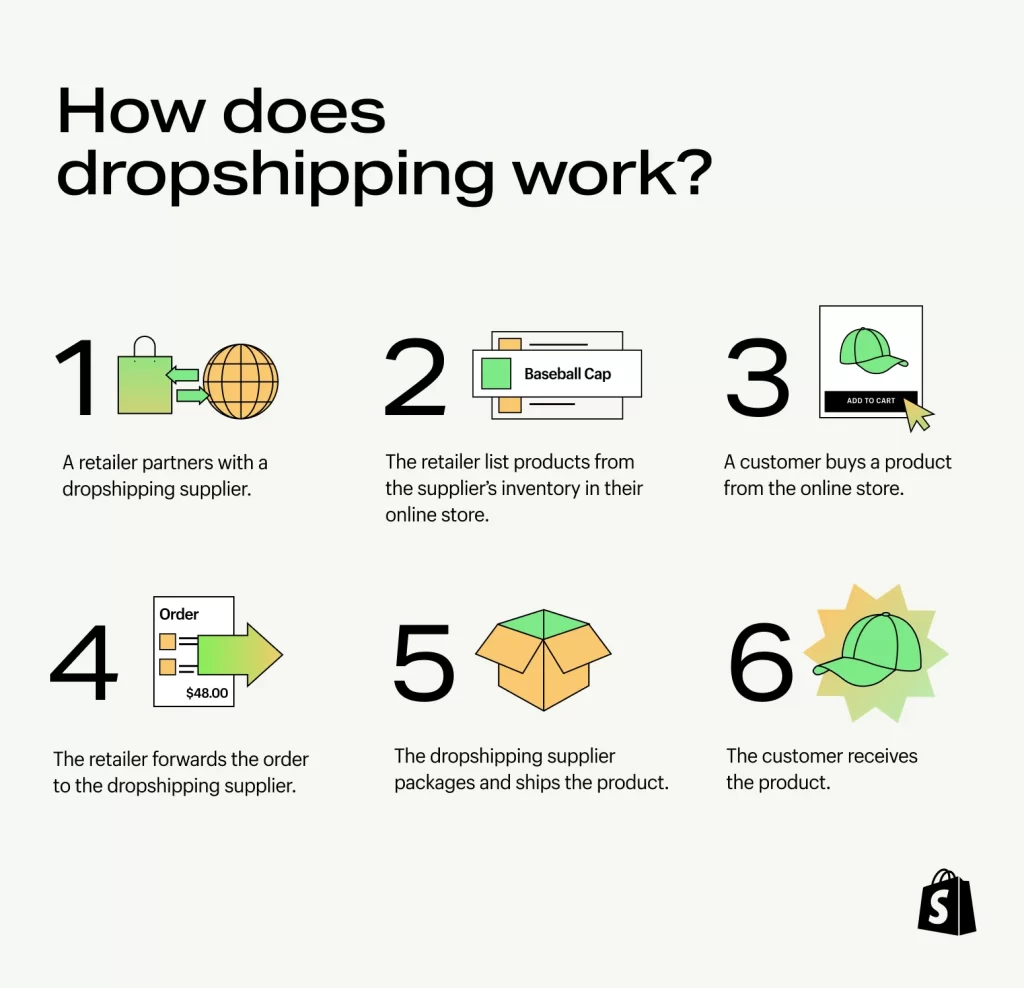Did you know that by 2023, the global dropshipping market was valued at over $225 billion, and India is rapidly emerging as a key player in this industry?
This explosive growth isn’t just a passing trend—it’s a sign that the e-commerce landscape is shifting, and more entrepreneurs than ever are tapping into the power of dropshipping to build online businesses. With the rise of e-commerce giants like Flipkart and Amazon India and the increasing popularity of online shopping, entrepreneurs in India have an unprecedented opportunity to tap into the dropshipping business model. The best part? You can start this business with zero inventory, from the comfort of your home.
But here’s the real kicker: while dropshipping is gaining traction, many Indian entrepreneurs still believe it’s “too competitive” or better suited to foreign markets. In reality, India’s growing middle class, widespread internet penetration, and robust logistics networks make it fertile ground for starting your dropshipping store. If you’re ready to break through these misconceptions, this guide will walk you through the process of launching your online business from scratch.
The Basics of Dropshipping: Why It’s Not as Easy as You Think
What Exactly Is Dropshipping?

Dropshipping is a business model where you don’t need to hold inventory or manage logistics. Instead, when a customer places an order on your online store, you forward that order to a supplier, who ships the product directly to your customer. This low-risk, low-investment model is ideal for aspiring entrepreneurs in India, especially at a time when online shopping is booming.
However, dropshipping isn’t an effortless way to make money. While you avoid the hassle of stocking products, you’ll still need to focus on aspects like supplier management, marketing, and customer service to thrive in this space.
Common Misconceptions About Dropshipping in India
It’s Only Profitable in the West
A common myth is that dropshipping is more suited to markets like the US or Europe. But with the growth of platforms like Meesho, Shopify India, and Flipkart—all supporting dropshipping—Indian entrepreneurs are finding success in this field. The key lies in choosing the right products and targeting the Indian audience through smart marketing.
Dropshipping is Too Competitive
Many people think dropshipping is oversaturated, but the truth is, that competition exists in any business. The Indian market is vast, with diverse customer needs that are often overlooked by large businesses. This creates opportunities for niche dropshipping businesses to thrive.
How to Start a Dropshipping Business in India: Step-by-Step Guide
Finding Your Niche: Think Local, Sell Global
While it’s tempting to sell the same products as everyone else, successful dropshipping businesses focus on niches. As an Indian entrepreneur, you have the advantage of understanding local tastes and trends that foreign sellers may miss.
How to Identify Profitable Niche Markets in India
Start by exploring products that appeal to Indian consumers but are less saturated. Use tools like Google Trends to analyze search patterns in India and e-commerce platforms like Amazon India to spot rising trends.

Examples of Unique Dropshipping Niches for India
Some less-explored niches that have potential include:
- Sustainable, eco-friendly products (e.g., bamboo toothbrushes, jute bags)
- Ethnic clothing and accessories for NRIs
- Ayurvedic skincare and health products
- Customizable gifts for Indian festivals (e.g., Diwali hampers, Holi products)
Choosing the Right Platform for Your Dropshipping Store in India
Platforms like Shopify India, WooCommerce, and Meesho are popular choices for Indian dropshippers. Each platform has its pros and cons, and your decision should depend on the type of business you want to build.
Why Shopify India Isn’t the Only Option
While Shopify is often the go-to for beginners, Meesho has gained popularity as a platform for social commerce and dropshipping in India, especially in Tier 2 and Tier 3 cities. Instamojo is another platform to consider, offering low-cost options for small businesses to sell online.
Finding Reliable Suppliers: An Indian Perspective
Working with Indian Suppliers vs. International Suppliers
When choosing suppliers, you can work with both Indian and international vendors. Indian suppliers often provide faster shipping times within the country, whereas international suppliers (like those on AliExpress) can offer a wider variety of products at lower costs.
How to Vet Suppliers in India
Before working with any supplier, check their reviews on platforms like Indiamart, TradeIndia, or Alibaba. Order samples to ensure quality, and communicate directly with suppliers to gauge their reliability. Popular Indian dropshipping suppliers include:
- GlowRoad (for fashion and home décor)
- Dropshipzone India (for electronics and lifestyle products)
- BaapStore (for multiple categories)
Building Your Indian Dropshipping Store: Design, Functionality, and Branding
Designing a Store That Resonates with Indian Consumers
In India, mobile-first design is essential as many e-commerce traffic comes from smartphones. Focus on creating a website that loads quickly, is easy to navigate, and highlights local payment options like UPI, Paytm, and Google Pay.
Creating a Brand Identity for the Indian Market
To succeed in dropshipping, branding is key. Your brand should reflect trust, quality, and a connection with Indian culture.
Highlighting Your Unique Selling Proposition (USP)
Whether it’s promoting eco-friendly products or celebrating traditional craftsmanship, your USP should appeal to Indian values and preferences. For example, a store selling sustainable fashion could highlight “Made in India” products, tapping into the growing demand for locally-made goods.
Marketing Strategies to Drive Traffic to Your Indian Dropshipping Store
Organic Traffic Strategies: SEO for the Indian Audience
Search Engine Optimization (SEO) can help drive organic traffic to your store. Focus on long-tail keywords that Indian consumers are searching for, like “eco-friendly home décor India” or “affordable ethnic wear online.”
Local SEO: Targeting Regional Markets
If you’re selling products with regional appeal, make sure to optimize for local keywords and create content in multiple languages, such as Hindi, Tamil, or Bengali. Use region-specific meta tags and descriptions to boost your visibility on local searches.
Paid Advertising: Facebook and Google Ads in India
Both Facebook Ads and Google Ads offer robust targeting options in India. On Facebook, you can segment your audience based on interests, location, and purchasing behaviour. On Google Ads, you can target high-intent users who are actively searching for products similar to yours.
Leveraging Indian Festivals and Shopping Trends
Indian consumers tend to spend more around festivals like Diwali, Eid, Raksha Bandhan, and Christmas. Create targeted ad campaigns around these key seasons to drive sales. For example, run special promotions on Diwali gifts or offer festive discounts on ethnic wear.
Common Challenges for Indian Dropshippers and How to Overcome Them
Shipping and Logistics in India
One of the biggest challenges for Indian dropshippers is managing shipping times and costs, especially for international suppliers. Look for domestic shipping partners like Delhivery, Shiprocket, or Blue Dart to ensure faster deliveries within India.
Managing Customer Expectations
Indian customers tend to be price-conscious and expect quick resolutions to any issues. Make sure your customer service is responsive, and consider offering Cash on Delivery (COD) options, which are still popular in India.
Is Dropshipping in India Right for You?
Who Can Succeed in Dropshipping in India?
Entrepreneurs who are resourceful, willing to put in the work, and open to learning can find success in dropshipping. Whether you’re based in a metropolitan city like Mumbai or a smaller town, India’s expanding e-commerce market presents countless growth opportunities.
The Future of Dropshipping in India
As India’s internet infrastructure improves and online shopping becomes even more widespread, dropshipping will continue to grow. By 2025, the Indian e-commerce market is expected to reach $111 billion, offering a huge market for dropshipping entrepreneurs who know how to position themselves.
Conclusion: Ready to Launch Your Zero-Inventory Business in India?
Now that you have a comprehensive guide to starting a dropshipping business in India, it’s time to leap. Dropshipping is not a get-rich-quick scheme, but with the right approach, it’s a powerful way to build a scalable business without heavy upfront investment. Whether you’re targeting Indian consumers or selling globally, the opportunity is vast. All it takes is research, dedication, and the willingness to adapt to the changing market.
Frequently Asked Questions (FAQs) About Dropshipping in India
1. What is dropshipping, and how does it work?
Dropshipping is a business model where you sell products without holding any inventory. When a customer places an order on your online store, you forward the order to a supplier who ships the product directly to the customer. This eliminates the need for upfront inventory and reduces risk.
2. Is dropshipping legal in India?
Yes, dropshipping is legal in India. However, it’s important to comply with local laws, such as ensuring that your business is registered, paying taxes (GST), and maintaining transparency with customers regarding delivery times and product origins.
3. How much money do I need to start a dropshipping business in India?
One of the key benefits of dropshipping is that it requires very little upfront investment. You’ll need money for creating and hosting a website, advertising, and product testing. Depending on the platform you use, you can start with as little as ₹10,000 to ₹20,000.
4. Which are the best platforms to start a dropshipping business in India?
Some of the best platforms for Indian dropshippers include:
- Shopify India
- Meesho
- Instamojo
- Flipkart Marketplace
- Woocommerce
These platforms offer easy integration with suppliers and payment gateways, making it simpler to launch your store.
5. How do I find reliable suppliers for my dropshipping store?
You can find suppliers on platforms like Indiamart, TradeIndia, GlowRoad, or even international options like AliExpress. Before partnering with any supplier, check their reviews, order samples to test product quality, and ensure they have reliable shipping methods.
6. What are some profitable dropshipping niches in India?
Profitable niches in India include:
- Sustainable and eco-friendly products
- Ethnic clothing and accessories
- Ayurvedic skincare and wellness products
- Pet Supplies
- Customizable gifts for festivals
Choosing a niche that caters to Indian consumer preferences will give you a competitive edge.
7. How do I handle shipping and logistics for dropshipping in India?
For domestic deliveries, you can partner with shipping providers like Delhivery, Shiprocket, Ecom Express, or Blue Dart. These services offer reliable shipping across India. If you are working with international suppliers, ensure they have a strong track record of timely deliveries and consider using tracking tools to keep your customers informed.
8. Can I do dropshipping internationally from India?
Yes, you can sell internationally from India through platforms like Shopify, WooCommerce, and Amazon Global Selling. Keep in mind that international shipping costs and delivery times can be higher, so it’s essential to be transparent with your customers and choose the right markets to target.
9. Is cash on delivery (COD) an option for dropshipping in India?
Yes, you can offer COD as a payment method through Indian platforms like Meesho and Flipkart, as many Indian consumers prefer this option. However, ensure that your supplier supports COD fulfillment and factor in potential additional costs for this payment method.
10. How can I promote my dropshipping business in India?
You can use multiple marketing channels, such as:
- SEO to attract organic traffic through targeted keywords.
- Social media marketing on platforms like Instagram, Facebook, and Pinterest, which are popular in India.
- Paid ads on Facebook and Google target Indian customers based on their preferences and location.
- Leveraging festive promotions around Indian festivals like Diwali, Eid, and Raksha Bandhan to boost sales.
11. How long does it take to become profitable in dropshipping?
There is no fixed timeline for profitability. Dropshipping is a competitive business model, and your success will depend on factors like your niche, marketing efforts, product selection, and customer service. Many entrepreneurs start seeing profits within 3 to 6 months, while for others, it can take longer.
12. How do I manage customer service in a dropshipping business?
Since you don’t handle the product directly, customer service is critical. Set clear expectations about delivery times, have a transparent returns policy, and stay responsive to customer queries via email, WhatsApp, or social media. Use automated systems or hire virtual assistants if the volume of inquiries grows.
13. Are there any risks associated with dropshipping?
Yes, dropshipping comes with risks such as:
- Low-profit margins due to competitive pricing.
- Dependence on suppliers for product quality and timely shipping.
- Longer shipping times for international products.
- Inventory issues, such as products going out of stock without your knowledge.
To mitigate these risks, choose reliable suppliers and maintain strong communication with your customers.
14. How do I scale my dropshipping business in India?
Once you’ve set up a profitable store, you can scale by:
- Adding new product categories or targeting international markets.
- Using advanced marketing techniques such as retargeting ads.
- Automating aspects of your business, such as order fulfillment and customer support.
- Creating a loyal customer base by focusing on exceptional service and building brand trust.
15. What is the future of dropshipping in India?
With India’s e-commerce market expected to grow to $111 billion by 2025, the future of dropshipping looks bright. As internet penetration increases in rural areas and online shopping habits become more ingrained, there’s ample opportunity for dropshipping businesses to flourish, especially in underserved markets.





